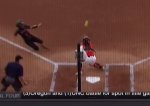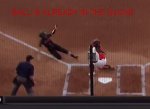What was the explanation in yesterday's game for not calling interference yesterday when the UGA runner contacted Fagan between 2nd and 3rd fielding a ground ball. Seems like it definitely impacted her ability to make a play either at 3rd or 1st.
The announcers said something about her not attempting to make a throw, had she attempted to make a throw to either 1st or 3rd, it would have been interference, but since she didn't even try, there was nothing to interfere with. Just what they said, I have no idea.







